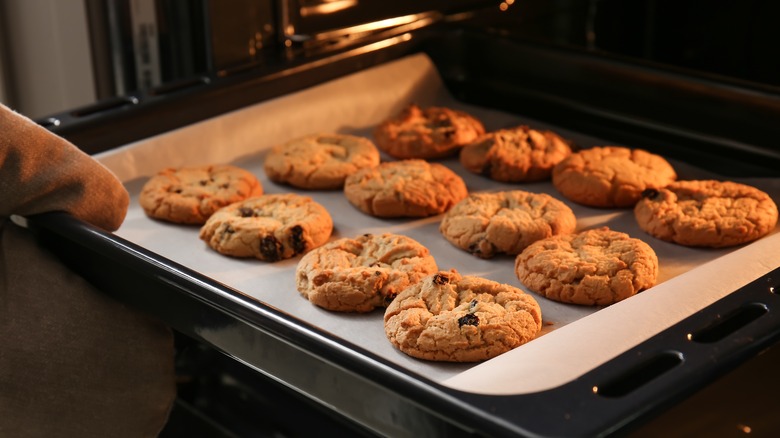What To Consider Before Making Cookies On Baking Sheets
Some characterize baking as a science because doing it well requires scientific precision – in other words, you should probably follow the recipe to the letter, even if you're not quite sure why. The reason is that, presumably, the recipe you're using has already been tested, tweaked, and tested again, on repeat until the final version yields the same result each time. Accordingly, deviating even slightly from the instructions may lead to disappointment. For example, if your cookie recipe tells you to measure your flour by weight, but you nevertheless pack it into a measuring cup, your cookies may turn out drier than you might otherwise be expecting. (And that's just one of the ways inaccurate measuring can ruin your cookies.)
On the other hand, some circumstances may leave you no choice but to improvise. For example, if your oven maintains its temperature by cycling on and off, as General Electric explains some do, it may be beneficial to rely on visual clues, rather than a timer to determine when your cookies are done. Similarly, if your cookie recipe calls for using cookie sheets (which are generally understood by recipe developers to refer to flat baking pans that are either rimless or have only one raised side) but you only have baking sheets, your baking time may require a bit of minor tinkering.
A complicated problem with a simple solution
Rimmed baking pans are also referred to as baking sheets, sheet pans, and baking trays. Because they tend to be sturdier and their rims can prevent freshly baked cookies from careening onto the floor on the journey from oven to cooling rack, they're the choice of many professional bakers (via Eating Expired). Conversely, cookie sheets are rimless or have a single rolled edge.
The flat profile of a cookie sheet allows for heated air to flow continuously over and around the cookies as they bake, according to Southern Living, and recipes that specifically call for cookie sheets are presumably calibrated with that airflow in mind. So if you're using a cookie recipe that calls for baking on cookie sheets, then, in the interest of precision, you'll want to do just that.
But you can still use a rimmed baking sheet to bake your cookies — with perfect results. The only wrinkle is you'll need to take into consideration that your recipe presumes the aforementioned airflow while baking, which your baking sheet will naturally not deliver. Complicated as that may sound, in practice it's an easy fix. If you're using a baking sheet when the recipe calls for a cookie sheet, simply set your timer for a minute longer than called for.

